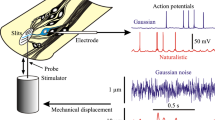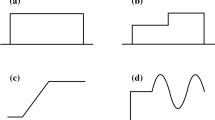Abstract
The nonlinear responses of deefferented primary muscle spindle afferent fibers to muscle stretching consisted of a train of action potentials which was analyzed when random changes in muscle length (band-limited gaussian white noise) were applied in cats. The upper cutoff frequency of the applied noise (the source stimulus) was varied between 1.6 and 570 Hz; the amplitude of the random input was varied between 0.002 and 1.2 mm. In a previous report the reverse correlation of 1st and 2nd order was studied for its ability to analyze data of a continuous input signal and pulsatile events in the output. Computations of the Wiener kernelsh 1 andh 2 or their equivalents, the perispike averages of the 1st and 2nd order, were computed from the random stretch responses of muscle-spindle afferents. Then the 1st- and the 2ndorder predictions and the summation of both to random muscle stretch was estimated. A general finding was that the 1st-order component was approximately 10 times that of the 2nd-order component, when both were combined in approximation procedures to give the closest prediction of observed responses to random test stimuli. The approximation was poor when the source stimulus was less than 0.03 mm and improved when it was greater. With the increase in the upper cutoff frequency of the random source input, the approximation worsened continuously. Predictions to ramp-and-hold stimuli were computed, as well as responses to random stimulation. Limiting the upper cutoff frequency did not diminish the value of the techniques applied.
Similar content being viewed by others
References
Boer E de, Kuyper P (1968) Triggered correlation. IEEE Biomed Eng 15:169–179
Boyd IA (1976) The mechanical properties of dynamic nuclear bag fibers, static nuclear bag fibers and nuclear chain fibers in isolated cat muscle spindles. Prog Brain Res 44:39–49
Bryant HL, Segundo JP (1976) Spike initiation by transmembrane current: a white-noise analysis. J Physiol (Lond) 260:279–314
French AS (1976) Practical nonlinear system analysis by Wiener kernel estimation in the frequency domain. Biol Cybern 24:111–119
French AS, Korenberg MJ (1989) A nonlinear cascade model for action potential encoding in an insect sensory neuron. Biophys J 55:655–661
Goslow GE, Reinking RM, Stuart DG (1973) Physiological extent and rate of muscle stretch for soleus, medial gastrocnemius and tibialis anterior in the cat. Pflugers Arch 341:77–86
Hasan Z, Houk J (1975) Transition in sensitivity of spindle receptors that occur when muscle is stretched more than a fraction of a millimeter. J Neurophysiol 38:673–689
Hunt CC, Wilkinson RS (1980) An analysis of receptor potential and tension of isolated cat muscle spindles in response to sinusoidal stretch. J Physiol (Lond) 302:241–262
Kearney RE, Hunter IW (1988) Nonlinear identification of stretch reflex dynamics. Ann Biomed Eng 16:79–94
Korenberg MJ, French AS, Voo SKL (1988) White-noise analysis of nonlinear behaviour in an insect sensory neuron: kernel and cascade approaches. Biol Cybern 58:313–320
Korenberg MJ, Sakai HM, Naka K-I (1989) Dissection of the neuron network in the catfish inner retina II. Interpretation of spike kernels. J Neurophysiol 61:1110–1120
Kröller J (1992) Band-limited white noise stimulation and reverse correlation analysis in the prediction of impulse responses of encoder models. Biol Cybern 67:207–215
Kröller J, Grüsser O-J (1982) Responses of cat dorsal spino-cerebellar tract neurons to sinusoidal stretching of gastrocnemius muscle. Pflugers Arch 395:99–107
Kröller J, Weiss L (1983) The silent period in the stretch response of Ia-activated dorsal spino-cerebellar tract neurons to sinusoidal muscle stretch in cats. Biol Cybern 48:195–199
Kröller J, Grüsser O-J, Weiss L (1985) The response of primary muscle spindle endings to random muscle stretch: a quantitative analysis. Exp Brain Res 61:1–10
Kröller J, Grüsser O-J, Weiss L-R (1988a) Observation on phaselocking within the response of primary muscle spindle afferents to pseudo-random stretch. Biol Cybern 59:49–54
Kröller J, Grüsser O-J, Weiss L-R (1988b) Superimposing noise linearizes the response of primary muscle spindle afferents to sinusoidal muscle stretch. Biol Cybern 60:131–137
Larkin RM, Klein S, Ogden TE, Fender DH (1979) Nonlinear kernels of the human ERG. Biol Cybern 35:145–160
Lee YW, Schetzen M (1965) Measurement of the Wiener kernels of a nonlinear system by cross-correlation. Int J Control 2:237–254
Lennerstrand G, Thoden V (1968) Dynamic analysis of muscle spindle endings in the cat using length changes of different lengthtime relations. Acta Physiol Scand 73:234–250
Mancini M, Madden BC, Emerson RC (1990) White noise analysis of temporal properties in simple receptive fields. Biol Cybern 63:209–219
Marmarelis PZ, Marmarelis VZ (1978) Analysis of physiological systems. Plenum Press, New York
Marmarelis VZ, Citron MC, Vivo CP (1986) Minimum-order Wiener modelling of spike-output systems. Biol Cybern 54:115–123
Matthews BHC (1933) Nerve endings in mammalian muscles. J Physiol (Lond) 18:1–53
Matthews PBC (1963) The response of deefferented muscle spindle receptors to stretching at different velocities. J Physiol (Lond) 168:600–678
Moore GP, Auriemma RA (1985) Prediction of muscle stretch receptor behaviour using Wiener kernels. Brain Res 331:185–189
Moore GP, Stuart DG, Stauffer GK, Reinking R (1975) White noise analysis of mammalian muscle receptors. In: McCann GD, Marmarelis PZ (eds) Proc of the 1st symposium on testing and identification on nonlinear systems. California Institute of Technology, Pasadena, pp 316–324
Pöpel B, Querfurth H (1984) The transducer and encoder of frog muscle spindles are essentially nonlinear. Physiological conclusions from white-noise analysis. Biol Cybern 51:21–32
Poppele RE (1981) An analysis of muscle spindle behaviour using randomly applied stretches. Neuroscience 6:1157–1165
Poppele RE, Bowman RJ (1970) Quantitative description of linear behaviour of mammalian muscle spindles, J Neurophysiol 33:59–72
Poppele RE, Quick DC (1981) Stretch induced contraction of intrafusal muscle in cat muscle spindle, J Neurosci 1:1169–1174
Sakai HM, Naka K-I, Korenberg MJ (1988) White noise analysis in visual neuroscience. Visual Neurosci 1:287–296
Sakuranaga M, Ando Y-I, Naka K-I (1987) Dynamics of the ganglion cell response in the catfish and frog retinas. J Gen Physiol 90:229–259
Schäfer SS, Schäfer S (1969) Die Eigenschaften einer primären Muskelspindelafferenz bei rampenförmiger Dehnung und ihre mathematische Beschreibung. Pflugers Arch 310:206–228
Schellart NAM, Spekreijse H (1972) Dynamic characteristics of retinal ganglion cell responses in goldfish. J Gen Physiol 59:1–21
Spekreijse H, Oosting H (1970) Linearizing: a method for analysing and synthesizing nonlinear systems. Kybernetik 7:22–31
Wiener N (1958) Nonlinear problems in random theory. Wiley, New York
Author information
Authors and Affiliations
Rights and permissions
About this article
Cite this article
Kröller, J. Reverse correlation analysis of the stretch response of primary muscle spindle afferent fibers. Biol. Cybern. 69, 447–456 (1993). https://doi.org/10.1007/BF01185416
Received:
Accepted:
Issue Date:
DOI: https://doi.org/10.1007/BF01185416




